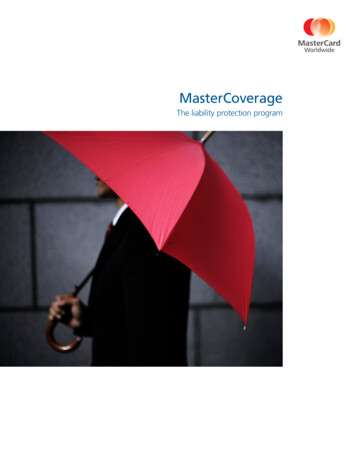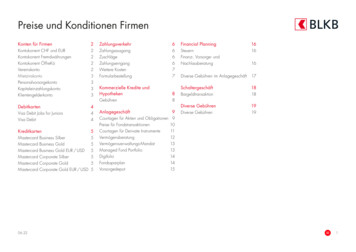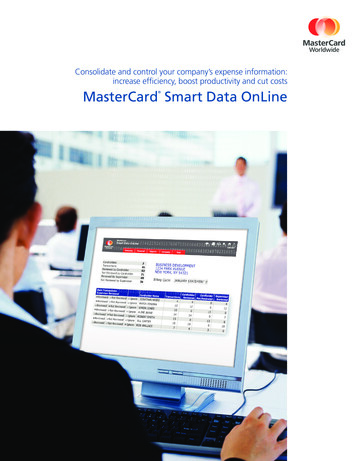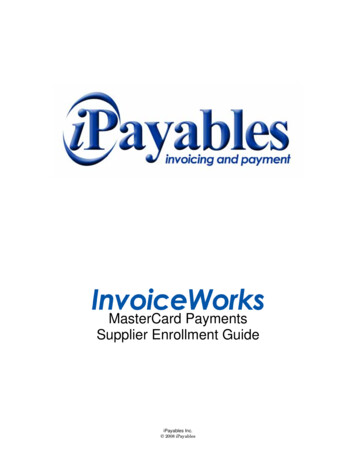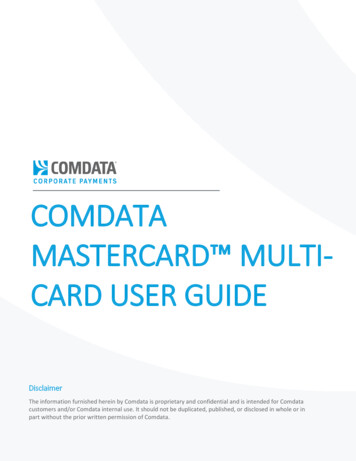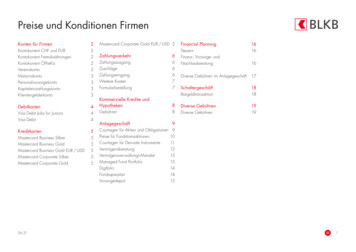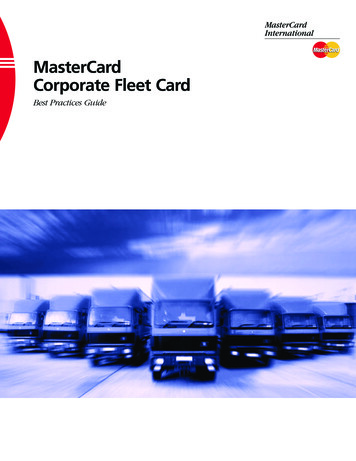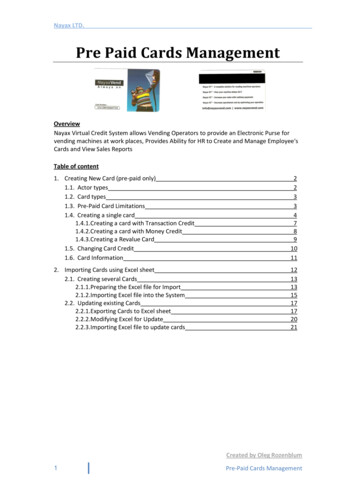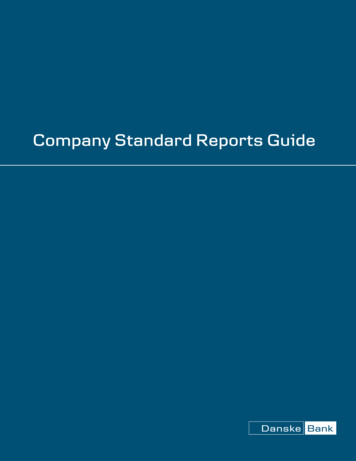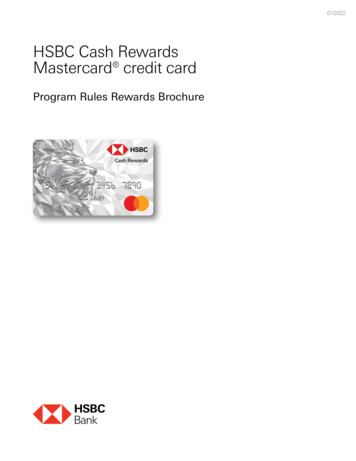
Transcription
MasterCardCorporate Purchasing CardBest Practices Guide
.: Table of ContentsIntroduction . . . . . . . . . . . . . . . . . . . . . . . . . . . . . . . . . . . . . . . . . . . . . . . . . . . . . . . . . . . . . . . . . . . . . 3Planning and Implementation . . . . . . . . . . . . . . . . . . . . . . . . . . . . . . . . . . . . . . . . . . . . . . . . . . . . . . .4Best Practice #1 . . . . . . . . . . . . . . . . . . . . . . . . . . . . . . . . . . . . . . . . . . . . . . . . . . . . . . . . . . . . . . . . . . . . . . . . . . .5Perform a Purchase Transaction AnalysisBest Practice #2 . . . . . . . . . . . . . . . . . . . . . . . . . . . . . . . . . . . . . . . . . . . . . . . . . . . . . . . . . . . . . . . . . . . . . . . . . . .6Quantify Purchasing Card Expansion ROIBest Practice #3 . . . . . . . . . . . . . . . . . . . . . . . . . . . . . . . . . . . . . . . . . . . . . . . . . . . . . . . . . . . . . . . . . . . . . . . . . . .7Form a Cross-Functional Program Enhancement TeamBest Practice #4 . . . . . . . . . . . . . . . . . . . . . . . . . . . . . . . . . . . . . . . . . . . . . . . . . . . . . . . . . . . . . . . . . . . . . . . . . . .8Set Performance GoalsBest Practice #5 . . . . . . . . . . . . . . . . . . . . . . . . . . . . . . . . . . . . . . . . . . . . . . . . . . . . . . . . . . . . . . . . . . . . . . . . . . .9Track PerformanceProgram Management . . . . . . . . . . . . . . . . . . . . . . . . . . . . . . . . . . . . . . . . . . . . . . . . . . . . . . . . . . . .10Best Practice #6 . . . . . . . . . . . . . . . . . . . . . . . . . . . . . . . . . . . . . . . . . . . . . . . . . . . . . . . . . . . . . . . . . . . . . . . . . .11Rationalize Expense Policies & ProceduresBest Practice #7 . . . . . . . . . . . . . . . . . . . . . . . . . . . . . . . . . . . . . . . . . . . . . . . . . . . . . . . . . . . . . . . . . . . . . . . . . .12Provide Comprehensive Training and CommunicationsBest Practice #8 . . . . . . . . . . . . . . . . . . . . . . . . . . . . . . . . . . . . . . . . . . . . . . . . . . . . . . . . . . . . . . . . . . . . . . . . . .13Optimize Purchasing Card DeploymentBest Practice #9 . . . . . . . . . . . . . . . . . . . . . . . . . . . . . . . . . . . . . . . . . . . . . . . . . . . . . . . . . . . . . . . . . . . . . . . . . .14Identify Ghost Account OpportunitiesBest Practice #10 . . . . . . . . . . . . . . . . . . . . . . . . . . . . . . . . . . . . . . . . . . . . . . . . . . . . . . . . . . . . . . . . . . . . . . . . .15Manage Supplier RelationshipsBest Practice #11 . . . . . . . . . . . . . . . . . . . . . . . . . . . . . . . . . . . . . . . . . . . . . . . . . . . . . . . . . . . . . . . . . . . . . . . . .16Leverage Data Integration OpportunitiesBest Practice #12 . . . . . . . . . . . . . . . . . . . . . . . . . . . . . . . . . . . . . . . . . . . . . . . . . . . . . . . . . . . . . . . . . . . . . . . . .17Use a Best Practice ScorecardCompliance, Audit and Reporting . . . . . . . . . . . . . . . . . . . . . . . . . . . . . . . . . . . . . . . . . . . . . . . . . . .18Best Practice #13 . . . . . . . . . . . . . . . . . . . . . . . . . . . . . . . . . . . . . . . . . . . . . . . . . . . . . . . . . . . . . . . . . . . . . . . . .19Establish a Sales Tax StrategyBest Practice #14 . . . . . . . . . . . . . . . . . . . . . . . . . . . . . . . . . . . . . . . . . . . . . . . . . . . . . . . . . . . . . . . . . . . . . . . . .20Use and Report on 1099 and MWBE SuppliersBest Practice #15 . . . . . . . . . . . . . . . . . . . . . . . . . . . . . . . . . . . . . . . . . . . . . . . . . . . . . . . . . . . . . . . . . . . . . . . . .21Manage by Exception
Table of ContentsProgram Expansion . . . . . . . . . . . . . . . . . . . . . . . . . . . . . . . . . . . . . . . . . . . . . . . . . . . . . . . . . . . . . . .22Best Practice #16 . . . . . . . . . . . . . . . . . . . . . . . . . . . . . . . . . . . . . . . . . . . . . . . . . . . . . . . . . . . . . . . . . . . . . . . . .23Mandate the Use of Purchasing CardsBest Practice #17 . . . . . . . . . . . . . . . . . . . . . . . . . . . . . . . . . . . . . . . . . . . . . . . . . . . . . . . . . . . . . . . . . . . . . . . . .24Expand Supplier AcceptanceBest Practice #18 . . . . . . . . . . . . . . . . . . . . . . . . . . . . . . . . . . . . . . . . . . . . . . . . . . . . . . . . . . . . . . . . . . . . . . . . .25Extend Purchasing Card Usage within the Procure-to-Pay EnvironmentBest Practice #19 . . . . . . . . . . . . . . . . . . . . . . . . . . . . . . . . . . . . . . . . . . . . . . . . . . . . . . . . . . . . . . . . . . . . . . . . .26Use a Single Card for Multiple Expense CategoriesBest Practice #20 . . . . . . . . . . . . . . . . . . . . . . . . . . . . . . . . . . . . . . . . . . . . . . . . . . . . . . . . . . . . . . . . . . . . . . . . .27Continuously Review for Program OpportunitiesThis Guide is provided AS IS for the convenience of and to assist MasterCard members and their customers. MasterCard makes no warranties, promises, or guaranteesabout, and shall have no liability to, members and their customers whatsoever under any legal or equitable theory arising from either parties’ use of this Guide.The information contained in this Guide is property and confidential to MasterCard Worldwide. The material may not be duplicated, published, or disclosed, in wholeor in part, without the prior written permission of MasterCard. Where applicable, both members and their customers must observe region specific requirements. Thesecan be discussed with each issuers’ MasterCard representative.
.: IntroductionAlthough purchasing cards have been in use for more than a decade, the world in which we use them has changeddramatically. The Internet revolution has made payment cards the method of choice for online buying, and yetchecks are still a mainstay in our payment toolbox. Most companies now have a different general ledger systemthan they did 10 years ago, but it is called an Enterprise Resource Planning (ERP) system. “Cost containment” hasreplaced “financial reengineering” as the watchwords. And we continue to find better ways to communicate withour suppliers electronically, whether we use an e-procurement system or an electronic invoice presentment andpayment (EIPP) solution.While the use of purchasing cards is now standard practice, our focus on their significant contribution to paymentefficiency may have become blurred. MasterCard Worldwide developed this guide to help companies jumpstart astalled program or rejuvenate one that is just coasting along. It describes a number of industry best practices usedby best-in-class organizations — those companies that have made purchasing cards a core component of theirpayment strategy.This guide tackles several factors that companies using MasterCard Corporate Purchasing Cards have brandedas barriers to success. By addressing such issues as sales tax and 1099 reporting in a straightforward manner,organizations will no longer see limits to their program, but endless opportunities.The identified best practices for MasterCard Corporate Purchasing Card programs are described in four key areas inthis guide:1. Planning and Implementation2. Program Management3. Compliance, Audit, and Reporting4. Program ExpansionThe roles of each within a typical Corporate Purchasing Card program are described below.Best Practice SegmentConcepts ExploredPlanning and ImplementationHighlights the importance of analyzing the organization’s ”as is” situationfirst and including the right people in its expansion plans, while settinggoals up frontProgram ManagementUnderscores the need to manage a program using the tools and data thatdefine purchasing cardsCompliance, Audit and ReportingIllustrates the use of reporting tools to ensure compliance without processoverloadProgram ExpansionDescribes tested approaches and recent innovations that keep theorganization focused on program growth3
Planning and Implementation4
.: Planning and ImplementationBest Practice #1Perform a Purchase Transaction AnalysisA thorough analysis of an organization’s purchase transactions will define its program enhancement opportunity. Bygathering and assessing a representative sample of historical transaction data, a company can develop a businesscase, set goals, and target areas for process change. It will also help prioritize deployment of resources forpurchasing cards and any related initiatives.A purchase transaction analysis can be conducted in one of three ways:1. Internally with IT support, financial system queries, and database management and spreadsheet programs2. Using pre-existing data warehouses and executive information systems3. Using an outsourced service bureau specialized in this disciplineThe outsourced service bureau approach has a number of advantages. It is the fastest, especially if internal resourcesare constrained or unavailable. Outside services also have the ability to augment payables system data withinformation from external directories, such as North American Industrial Classification System (NAICS) codes, thesuccessor to Standard Industrial Classification (SIC) codes. Payee names can also be matched to directories of cardaccepting suppliers with enhanced data indicators.A purchase transaction analysis is the first, key step in launching a program expansion initiative. It provides the dataneeded to identify areas of opportunity, prioritize implementation steps, and quantify potential benefits in a formalbusiness case. Communicating the opportunities throughout an organization is easiest when the facts are evident.Key Success FactorsMethods of AchievementExpense types targetedAnalyze all payments to identify expense types that qualify for purchasingcard usageKey suppliers, locations, andend users identifiedHighlight vendors, offices, plants, and potential buyers that warrantfocused purchasing card usageCosts and benefits measuredQuantify discounts lost, purchase orders (POs) processed, checksrequested, and order methodsImplementation phases definedCost savings ranked vs. ease of implementation for target expense types,suppliers, locations, and end usersBenefits Realized:. Hard data to develop a compelling business case:. Baseline statistics for making rational projections:. Detailed metrics to prioritize opportunities for implementation planning:. Comprehensive information to set program scope5
Planning and ImplementationBest Practice #2Quantify Purchasing Card Expansion ROIQuantifying return on investment for a company’s program expansion efforts will solidify the underlying businesscase. The data produced by a purchase transaction analysis becomes the foundation for the ROI calculations. It is alsoimportant to review the current procure-to-pay process and map out the costs associated with how things are donetoday. The comparative costs of paper management vs. purchasing card usage will result in quantifiable savings.The various combinations of procurement and payment methods in an organization will be identified during thepurchase transaction analysis. These should now be reviewed individually to determine people time, system costs,and third-party processing expenses associated with each procure-to-pay combination. When the cost for eachhas been quantified, the “as is” volumes can be used to establish the current cost structure. Process changeopportunities identified during the purchase transaction analysis can then be quantified as well, producing bottomline savings from expanded Purchasing Card deployment.Senior management looks favorably upon realizable savings presented in a compelling business case. Taking the timeto map out a corporation’s procure-to-pay cost structure, and quantifying the ROI from instituting processimprovements, will ensure commitment from the very top of the organization.Key Success FactorsMethods of AchievementProcess costs mapped- Identify procure-to-pay method combinations- Review process implications in terms of people time, system usage, andthird-party providers- Quantify the cost of each process step and the resulting combinationsJustifiable ROI- Use volumes identified in purchase transaction analysis to determinecurrent cost structure- Calculate savings opportunity from process changes highlighted bypurchase transaction analysisSolid business case- Substantiate process savings with other benefits such as employeeempowerment and focus on strategic vendor contractsBenefits Realized:. Management commitment and project sponsorship:. Cross-functional buy-in:. Clear program expansion objectives6
.: Planning and ImplementationBest Practice #3Form a Cross-Functional Program Enhancement TeamA cross-functional team is the driving force behind a successful program enhancement initiative. It should becomprised of representative stakeholders who are committed to achieving program growth and process efficiencies.These individuals provide expertise in functional, financial, regulatory, and control-related disciplines to guide theproject early in its lifecycle and avoid barriers to success.The following areas should be represented::. Accounts Payable:. Information Technology:. Procurement:. Human Resources:. Finance/Accounting:. Corporate Marketing and Communications:. Internal Audit:. Legal:. TaxOther key members include::. Senior Management sponsor:. Project Manager:. User representatives:. Issuing Bank representatives:. Third-Party ProvidersNot all representatives will be active participants in every meeting; some will be solicited for input on an as-neededbasis. However, engaging and informing these stakeholders at the onset of the project will demonstrate a spiritof cooperation and respect for their areas of expertise. Effective implementation is all but assured with amulti-discipline team.Key Success FactorsMethods of AchievementDiverse representation- Gain executive sponsorship for the project and cross-functionalrepresentation- Identify key representatives of stakeholder disciplines- Develop a compelling business case and communicate it to prospectiveteam members- Engage current buyers and new cardholders to provide feedback onchanging processesProject management experience- Identify a team leader with experience leading projects, as well as avested interest in program expansionBenefits Realized:. Optimal process redesign:. Financial integrity and appropriate controls:. Effective communications and user training:. Avoidance of last minute crises7
Planning and ImplementationBest Practice #4Set Performance GoalsPerformance goals establish the benchmarks against which program expansion can be measured. The underlyingbusiness case includes expectations for financial benefit, while performance goals allow the project team todemonstrate the cumulative value of the initiative.Goals should be quantified consistent with the objectives of the organization and reflect the principles of thesupporting business case. There should be a goal for each::. Category of cost and benefit:. Affected function and location:. Measurable dimension of the process:. Time frame going forwardFor example, a goal might be set for the percentage of employees with cards, or for the number of purchase orderseliminated in the first year of implementation.Goals help define the program expansion opportunity and make it tangible across an organization. Used inconjunction with performance tracking, they demonstrate progress or highlight barriers to success. Broadlycommunicate the organization’s program expansion goals to achieve the highest level of cooperation.Key Success FactorsMethods of AchievementDefined program goals-Accountability for achieving goals- Identify specific functional areas responsible for implementing processchanges- Develop job objectives consistent with program goal achievementEstablish overall business objectivesIdentify cost and benefit categoriesHighlight affected functions and locationsDetermine measurable dimensions of the processDefine measurement time framesDevelop realistic projections for the expanded programBenefits Realized:. Clearly defined program objectives:. Motivated employees:. Measurable results:. Accountability for process change8
.: Planning and ImplementationBest Practice #5Track PerformancePerformance tracking helps the organization to effectively manage program expansion and sustain long-termcommitment to its Purchasing Card program. Program performance can be measured along several parameters,and reported to both line and senior management, to demonstrate progress or justify the need for resources andcross-functional cooperation.Once program goals have been quantified, the project team will need to establish baseline metrics for reporting,such as cardholders as percentage of total employees. They will also need to identify the source for each data pointsuch as Accounts Payable, specialized service bureau, and card management system. To communicate progress,standard reporting formats and schedules should be developed which are consistent with the receiving audience.Keeping expansion progress in front of management will ensure ongoing support, as well as assistance whenbarriers are encountered. Proving the value of the underlying business case will demonstrate that Purchasing Cardscan be effectively deployed throughout the organization.Key Success FactorsMethods of AchievementDetailed reports to line- Collect and compile quantifiable datamanagement monthly- Prepare progress reports comparing actual results against performanceperformance goalsImplementation barriers removed- Use reports to identify and highlight issues- Recommend resolutions or seek input from line managementSummary reports to seniormanagement quarterly or annually- Present highlights of performance progress against goals- Recognize performance leaders- Acknowledge broad-reaching concerns that require managementcooperationBenefits Realized:. Visible progress against performance goals:. Validation of the underlying business case:. Early detection of potential barriers:. Identification of additional growth opportunities9
Program Management10
.: Program ManagementBest Practice #6Rationalize Expense Policies & ProceduresEstablishing or expanding a MasterCard Corporate Purchasing Card program provides an ideal opportunity to reviewan organization’s current expense policies and procedures. This review may uncover old policies that need to beupdated or identify new policies that coincide with using Purchasing Cards. Some procedures will need to bemodified or replaced when cards are introduced as a payment option. Corporate Purchasing Cards should be viewedas a catalyst for reengineering, rather than just a payment tool.The cross-functional project team should incorporate a policy and procedures review into the project plan. Oneapproach is to assign one or two individuals to study current expense policies, while another small group documentscurrent procedures for procurement, approval, and payment of goods and services targeted for Purchasing Card use.The stated policies should be compared to actual procedures, noting where there are differences in practice.Existing policies should also be rationalized going forward with regard to traditional payment methods andPurchasing Cards. For example, purchasing authority levels may need to be adjusted with more employees havingprocurement capability using the card. These policies will then drive the guidelines for card limits and use privileges.They should also address procedures such as transaction reconciliation and management sign-off.Policy and procedure rationalization will send a clear message to management and the rest of the company that theorganization is willing to make changes that lead to operational efficiency without sacrificing controls. It will alsohelp the project team communicate the new or enhanced program to employees, as it will have a simpler messageto share at an opportune time.Key Success FactorsMethods of AchievementUpdated expense policies- Review current policies in detail- Identify dated policies and make them current- Develop new policies where needed in support of Purchasing Cards as apayment toolEfficient procurement andpayment procedure- Document current procurement and payment procedures- Compare procedures to policies and make modifications whereappropriate- Establish new or modify current procedures to address the use ofPurchasing Cards as a payment tool with pre-authorized limitsBenefits Realized:. Efficient and effective procedures for procurement and payment:. Clear and unambiguous expense policies:. Established guidelines for card limits and usage11
Program ManagementBest Practice #7Provide Comprehensive Training & CommunicationsEffective training and focused communications are critical to the success of any new initiative. Purchasing Cardprogram expansion is no exception! The rationale for the initiative must be understood by almost everyone;appropriate groups need to be trained on using the card, or its impact on current procedures. In addition, variouslevels of management need to be aware of program performance and personal accomplishments.The first step is to define what messages need to go to which audiences, both during the project and afterimplementation is complete. The method and frequency of communication will be dependent upon the audience.A company-wide e-mail or inbox letter from the CEO or CFO can kick off the program, but project team membersmay need a dedicated intranet site to reference, and line management will need monthly reports of programperformance. All employees should be apprised of program milestones and new usage opportunities to maintainmomentum. A company newsletter or intranet site can facilitate this type of broad communication.Training will also need to be developed and conducted consistent with the audience and the level of detail required.Card user training will be very different from training for the Accounts Payable (A/P) department, the PurchasingDepartment, or Information Technology (IT) team.Communication not only generates buy-in, but avoids surprises and misunderstandings. A well-plannedcommunications strategy on the front-end keeps everyone well informed and onboard. Similarly, a formal trainingprogram helps the program ramp-up more quickly as card users and program participants are confident in theirability to adopt the new procedures.Key Success FactorsMethods of AchievementProject Manager not overrunwith questions (by phone or e-mail)- Keep senior management informed of project progress- Keep project team up-to-date on implementation activities- Identify department / region contact points early onProgram Administrator/Accounts Payable Manager/Purchasing Manager not overrunwith questions (by phone or e-mail)- Establish regular program performance reporting tomanagement- Develop targeted training for card users and function areasIssuing bank’s customer servicenot overrun with questions- Develop targeted training for card users- Establish feedback mechanism (satisfaction survey) for cardholdersBroad-reaching, regularcommunications- Identify a communications method that reaches the whole company(newsletter, e-mail, intranet site update)- Follow any pre-established schedule for publication or develop one thatkeeps the message fresh with unique success storiesBenefits Realized:. Supportive management:. Commitment to regular communications:. Increased cooperation between departments:. Empowered employees:. Faster program expansion12
.: Program ManagementBest Practice #8Optimize Purchasing Card DeploymentCorporate Purchasing Cards should be deployed where the organization has concentrations of end users,commodities purchased, and spending that fit the Purchasing Card profile such as low-value, high-volume, indirectgoods and services. A purchase transaction analysis will yield valuable data for determining where these pockets ofopportunity lie.The first cut should look at transactions that fall below the organization’s “low-value” threshold. This value may bethe cutoff for capitalizing expenses, or it might be 1,000 for office supplies and 5,000 for computer hardware.While the 80/20 rule is often applied here (80% of the transactions amount to only 20% of the dollars spent),many organizations see 90% of their purchase transactions totaling only 5% of their non-payroll dollars. Higherthresholds, such as 2,500 or 5,000, have become a best practice as the industry has seen risk-averse organizationsseverely limit their program potential.Once the value threshold is established, look at concentrations of commodities/suppliers and employee locationswhere these low-value purchases are being made. The organization can then begin to prioritize commodities andspecific suppliers to target for card usage (or acceptance, if there is sufficient leverage) and offices where there aremany end users who would benefit from having a card.By analyzing a corporation’s own data, it can determine where to target its Purchasing Card spend, and whichsuppliers and locations to implement first, to reach the low hanging fruit, and plan for the more difficultopportunities.Key Success FactorsMethods of AchievementPurchasing card transactionthreshold- Apply 80/20 rule to purchase transactions- Review capitalization threshold- Consider expense authorization policiesTarget commodities- Identify commodities (including services) that typically fall below thepurchasing card threshold- Review purchasing and payment methods for those commoditiesKey suppliers- Identify suppliers used for target commodities- Highlight national suppliers that could be used more to the company’sadvantage- Determine which key suppliers already accept cards and what level oftransaction data they provideGeographic concentrations- Identify departments, offices, or regions where the number of end usersjustifies on-site vs. remote program implementationBenefits Realized:.:.:.:.Quicker volume ramp-upStronger vendor relationshipsLogical prioritization of opportunities (easy/large vs. hard/small)Cost-effective implementation13
Program ManagementBest Practice #9Identify Ghost Account OpportunitiesA ghost account, or virtual card used to facilitate purchases from a supplier, can be very effective when numerousemployees order from the same supplier, and many of those individuals don’t order other goods or services oftenenough to justify having their own Purchasing Cards. Department cards and project cards may have actual plastics,but various employees are authorized to use them with the proper controls in place. Reconciliation of all theseaccounts must be handled centrally, by the vendor manager in the case of ghost accounts, and the department orproject manager in the case of department cards and project cards.To properly manage a ghost account, the supplier should be able to at least capture Level II merchant information.If ordering is done over the phone, employees should be asked for a cost center or employee number that iscaptured in the customer number field (POS code). This allows purchases to be automatically posted to the correctdepartment. If purchases are made online, the purchase order (PO) number can be captured in the customer numberfield to reconcile payment by Purchasing Card. There should also be language in the vendor agreement stating thatthe supplier is required to ask for the cost center or employee information, and is liable for unauthorized activity.The card issuer can help an organization restrict use of a ghost account to the supplier’s merchant category code(MCC), and possibly to that supplier alone, further reducing the chance for unauthorized use.Ghost accounts and department/project accounts can be used in situations where individual Purchasing Cards don’tadd value, such as e-procurement systems that impose limits and accountability on the buyer. They can addsubstantially to program spend, generating both cost efficiencies and financial rewards.Key Success FactorsMethods of AchievementEffective ghost account- Identify suppliers used by many employees, several of which can’t justifyarrangements having their own Purchasing Card- Ensure Level II merchant data can be captured for phone or online orders- Require supplier to collect purchase ID from employees on all phoneorders and to be responsible for unauthorized use of the accountnumber- Limit the account to only that supplier, or at least their MCC- Make one individual accountable for reconciling the ghost accountEfficient departmentproject cards- Establish card usage controls, such as a sign-out log or transaction ordocumentation- Make one individual accountable for reconciling the department orproject cardBenefits Realized:. Supplier efficiencies:. Key supplier leverage:. Department or project expense control:. Incremental program volume:. Faster program ramp-up14
.: Program ManagementBest Practice #10Manage Supplier RelationshipsActivity with all suppliers should be tracked and monitored to efficiently manage and potentially reduce the overallnumber of supplier relationships. This allows management to understand the importance of each relationship whilechoosing the most effective payment mechanism for each supplier.Vendor Management is typically the responsibility of the Purchasing or Accounts Payable departments, where newsuppliers are authorized and vendor contracts are negotiated. One goal of a Purchasing Card program is to usereporting data to leverage strategic supplier relationships, while minimizing the number of suppliers set up on theAccounts Payable system. Card reporting data from the card issuer, the MasterCard Supplier Directory and theMasterCard Enhanced Merchant Reporting System, in conjunction with output from the organization’s AccountsPayable system, can be used to accomplish this two-fold objective.Spend data organized by supplier can help an organization negotiate better volume-based pricing with strategicsuppliers, identify and cur
The identified best practices for MasterCard Corporate Purchasing Card programs are described in four key areas in this guide: 1. Planning and Implementation 2. Program Management 3. Compliance, Audit, and Reporting 4. Program Expansion The roles of each within a typical Corporate Purchasing Card program are described below.
